AI use cases: insights from AI's leading decision makers
Researched by Paradoxes and supported by Kore.ai, this report covers how enterprise leaders think about AI, primary use cases, challenges, success metrics, and planning.


About the report
AI Use Cases: Insights from AI Decision Makers – 2025 represents our research findings on how enterprise leaders think about AI, primary use cases, challenges, success metrics, and planning for future AI. Researched by Paradoxes and supported by Kore.ai, this report is an extension of the master report – Practical Insights from AI Leaders, which offers a global perspective on how leading organizations are operationalizing AI—reshaping business models, accelerating innovation, and creating competitive advantage.
Based on insights across industries and regions, this report focuses on what’s top of mind: the priorities, investments, and talent strategies driving the next phase of AI adoption. Whether you’re deploying initial pilots or refining an enterprise-wide AI strategy, this report delivers the intelligence needed to lead with confidence in an era defined by transformation.
Research methodology
Inside the minds of global AI decision-makers: what 800+ leaders told us about enterprise AI
In March 2025, Kore.ai partnered with Paradoxes, Inc. to conduct a comprehensive global study on the state of AI in the enterprise, examining top-of-mind questions for scaling with AI, from executive outlooks and real-world use cases to adoption strategies, build vs. buy decisions, and the criteria shaping vendor and technology choices. It also looked ahead, uncovering the emerging challenges, talent gaps, and investment priorities shaping the next wave of AI transformation.
The survey gathered insights from over 800 senior business and technology leaders across 12 countries, including the U.S., UK, Germany, UAE, India, Singapore, Philippines, Japan, Korea, Australia, and New Zealand. Participants represented senior executives from large enterprises, each with over 800 employees and $250M+ in annual revenue, that were actively exploring or implementing AI initiatives.
Key findings
1. Organizations embrace AI across departments.
Across industries and geographies, enterprises are shifting from exploring AI to embedding it into core business functions. 71% of organizations report that they are actively using AI across multiple departments and use cases.
2. AI is serving the workplace use cases, for business process automation & orchestration, and for customer service use cases.
Process orchestration is the top use case, accounting for 44%. AI in the workplace follows at 31%, with enterprises deploying it to enhance employee productivity. AI for customer service claims 24% and is being adopted to deliver better and faster support.
3. Enterprises measure the success of each AI use case by clear, tangible results.
Enterprises prioritize employee productivity as the top success metric for AI workplace initiatives. For AI in business process orchestration, they focus on improving operational efficiency. When using AI for customer service, they track success primarily through increased customer satisfaction.
4. 89% of enterprises plan to increase AI investments in 2025 and beyond.
Regardless of the use case, 89% of enterprises say they will increase their AI investments, while 9% say it will stay the same, and only 1% say they will decrease it.
5. Enterprise AI leaders prefer to buy and customize AI solutions than to build from scratch.
72% prefer purchasing and customizing AI solutions over building them internally. Trust and reputation are key factors in vendor evaluations, with model output quality, efficiency, and integration cited as the top decision-making factors.
Organizations embrace AI across departments
AI goes mainstream with widespread enterprise adoption

Regardless of industry and geography, organizations are looking for ways to leverage AI technology. 71% of respondents surveyed say that their organizations are actively using AI across multiple departments and use cases, signaling that it’s moved from small pilots to widespread, day-to-day operations.
Less than a quarter (24%) are still in the experimentation phase, exploring AI in limited use cases, while just 5% remain in the early research stage.
Notably, none of the surveyed companies said they’re waiting to evaluate AI in the future or believe their teams aren’t capable of using it, underscoring that AI hesitation is over.
Organizations are scaling AI across departments
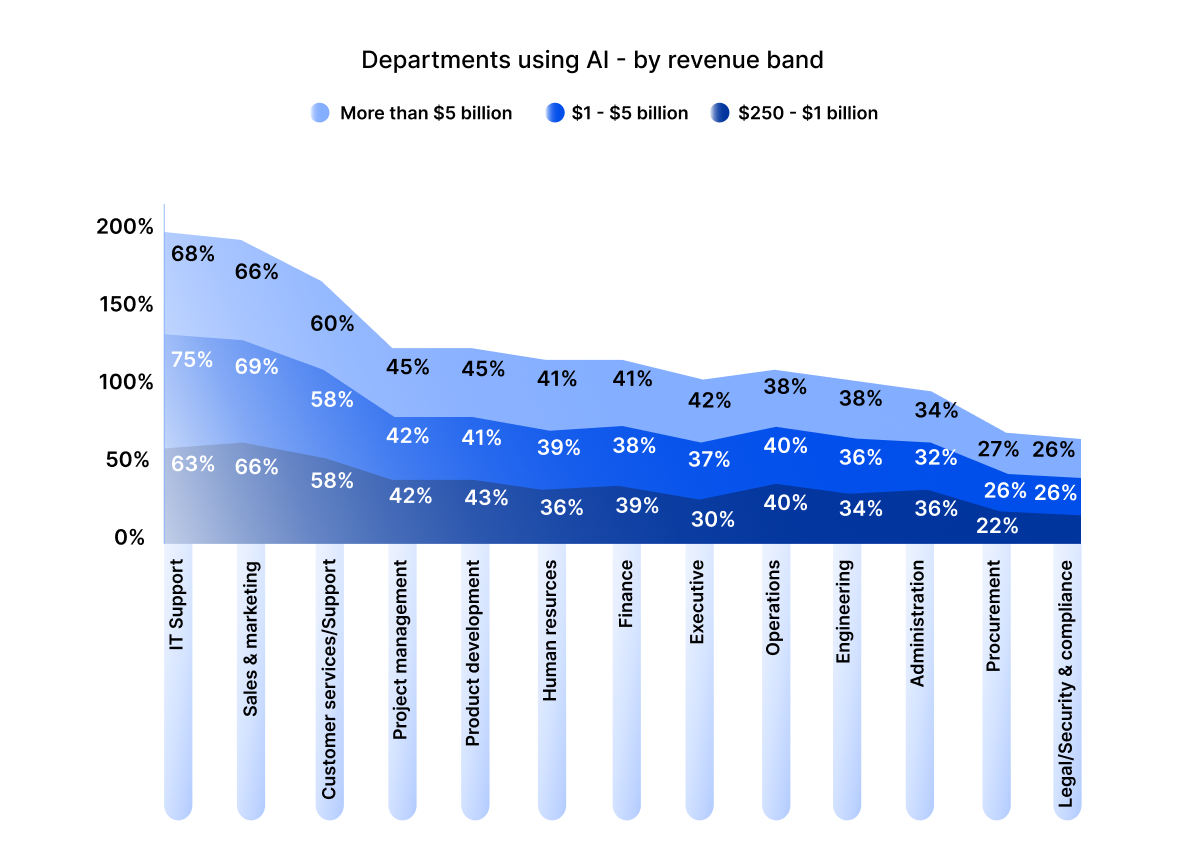
As organizations roll AI solutions out to different departments, they’re reaching beyond early adopters. IT support leads the way at 69%, emerging as the most AI-enabled department across nearly all revenue bands, followed closely by customer service (59%) and marketing (45%).
Departments like finance, HR, product development, and project management are seeing moderate AI uptake, while legal (24%) and sales (21%) show the lowest levels of AI use, suggesting these functions may still be cautious about AI integration.
AI adoption centers on process, workplace, and service functions across revenue bands.
The role of AI within organizations is becoming more strategic and targeted. Instead of isolated experiments, most enterprises are channeling their efforts into three primary business use cases: improving the workplace, enhancing customer service, and automating processes.

Regardless of revenue, organizations agree that process automation is the most important use case, accounting for 44% of all responses. From compliance and risk management to workflow automation, businesses are using AI to reduce friction and improve consistency in day-to-day operations.
AI in the workplace follows at 31%, with enterprises deploying it to enhance employee productivity. Common applications include task automation, analytics, idea generation, information discovery, and content creation, augmenting how employees work, learn, and make decisions.
AI for customer service claims 24% and is being adopted to deliver better, faster, and more scalable support through applications like chatbots, virtual assistants, and translation.
Industries are aligning AI usage to their core business priorities
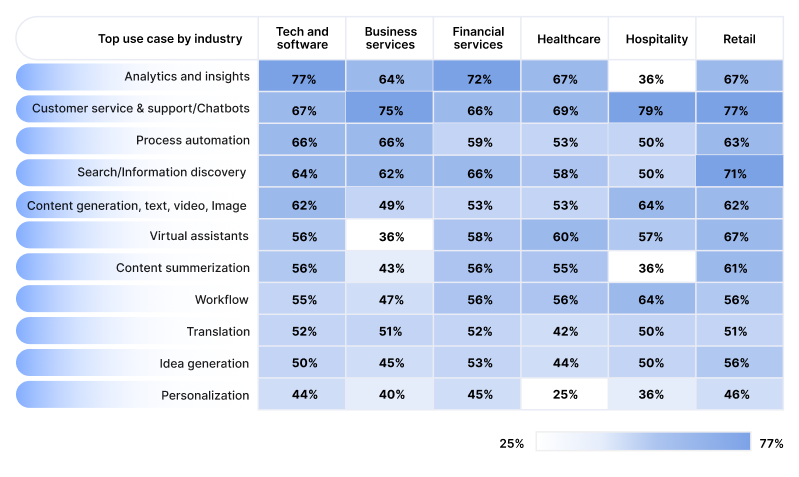
Industry-specific adoption patterns show how different sectors are aligning AI with their core business needs.
In technology and software, and financial services, the focus is firmly on insights and analytics, with 77% and 72% respectively, highlighting the role of data as a competitive edge.
Retail, business services and healthcare are leaning toward AI for customer service and support, with 77%, 75%, and 69%, respectively, reflecting their customer-centric operating models.
Meanwhile, process automation use cases are gaining traction across business services (66%), technology and software (66%), and retail (63%), signaling a growing need to optimize processes.
AI priorities vary by region
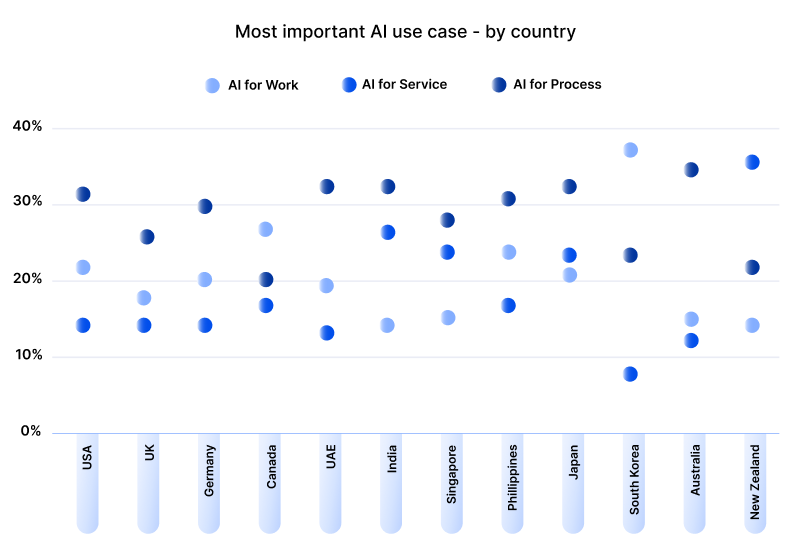
In Western markets like the US, UK, and Germany, there’s a clear consensus towards using AI for process automation and orchestration, followed by workplace-related cases, while customer service use cases take third place. This pattern reflects a focus on enterprise-grade efficiency and operational scale.
In India and Southeast Asia, while process orchestration remains a top priority, the customer service use cases take second place over workplace use cases, indicating a stronger emphasis on customer engagement in fast-growing digital economies.
Japan and South Korea, though geographically close, show contrasting priorities. Japan mirrors India, placing the process orchestration first and customer service second. South Korea, however, places workplace use cases at the top (37%), showing a greater emphasis on employee productivity.
Australia follows the broader global trend of placing process orchestration first. But New Zealand flips the pattern entirely, making AI for customer service its top priority (36%), a signal of its sharper focus on customer-facing transformation.
The UAE aligns with Western economies, focusing more on process orchestration, followed by workplace use cases, and then customer service.
AI is now an everyday companion for employees, actively powering daily workflows across roles and functions. From finance teams to marketers to HR teams, enterprises are using AI to augment human capability, helping employees to work faster and with greater impact.
Information-led use cases lead workplace AI adoption

Examining how AI is applied in workplace use cases reveals a clear hierarchy. Analytics and insights top the list, underscoring the enterprise’s need for data-driven decision-making.
This is followed by information discovery, where AI is helping employees in information discovery through complex knowledge repositories. Content generation and workflow optimization are also gaining traction, whereas idea generation and translation, while still niche, show signs of value.
Workplace AI finds the fastest traction in data-heavy sectors

The data suggests that industries like insurance, energy, and pharmaceuticals are predominantly adopting workplace use cases, where the burden of documentation and data-intensive processes creates a natural fit for such applications.
Automotive, business services, and healthcare organizations are also embracing AI in the workplace, following closely behind the early adopters. In contrast, industries such as hospitality, telecommunications, and travel, which rely heavily on customer service and person-to-person interactions, are looking less towards using AI for workplace use cases.
Workplace AI readiness hinges on talent and data security
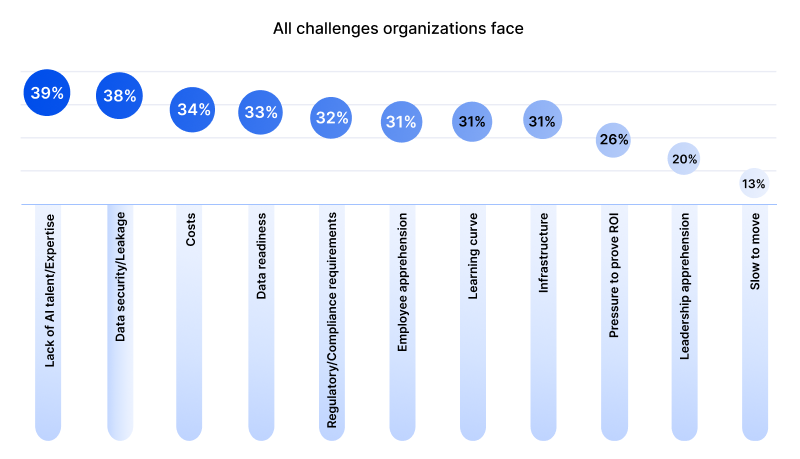
The main challenges to implementing AI for the workplace are a lack of talent (39%), data security and leakage (38%), and the cost of LLMs (34%). This shows that organizations need to revisit their AI strategy, where they start embedding AI readiness into workforce planning, prioritizing secure-by-design architecture, and shifting from large deployments to iterative, low-risk rollouts.
Interestingly, only about a quarter of participants mentioned concerns like slow decision-making, leadership hesitation, or pressure to prove ROI, suggesting that most organizations have strong leadership support and enthusiasm for AI.
Organizations demand tangible results from AI
Organizations are measuring success in the AI for the workplace domain through a practical lens, prioritizing operational efficiency (13.9%), employee productivity (10.5%), and output quality and consistency (11%). This signals that enterprises are holding AI to high standards and expecting clear, tangible improvements in work performance.
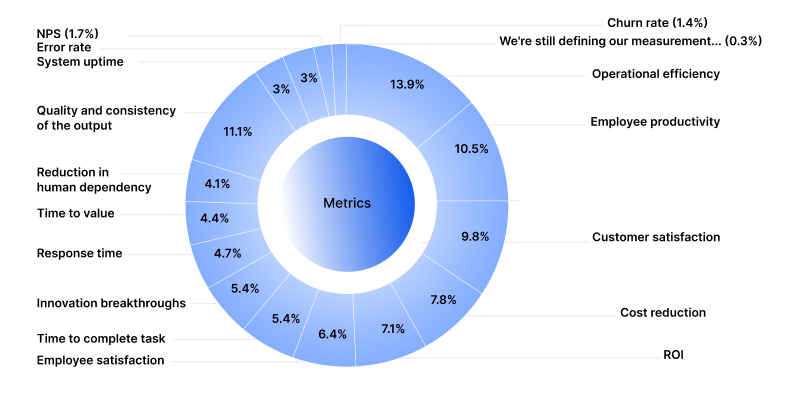
Enterprises prioritize building AI expertise
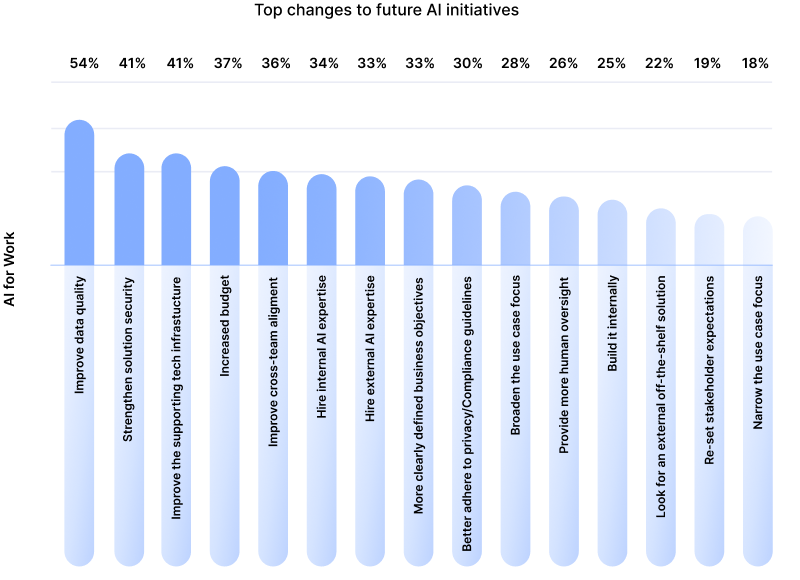
Looking back on past AI initiatives, more than two-thirds of organizations plan to strengthen their AI expertise, either by upskilling internally (34%) or hiring externally (33%).
In addition to hiring the right talent, more than half plan to improve data quality as they work on their next AI initiatives. Other key improvement areas include solution security and improving the underlying technology infrastructure.
High confidence in AI for workplace use cases
Despite the challenges and learning curve, enterprise confidence in applying AI for workplace use cases remains high. 89% of organizations plan to increase investment over the coming months. 9% of organizations say that it will stay the same, and only 1% say they’ll scale back.

AI for the workplace use cases is no longer on the sidelines and is becoming part of how modern teams think, operate, and grow.
AI use cases for process orchestration: reimagining operations
As enterprises move from AI interest to AI integration, process automation has emerged as one of the most powerful and widely adopted use cases. From workflow automation and compliance checks to improving consistency and reducing manual dependency, AI for business process orchestration is becoming a key lever for large-scale transformation.
Organizations are no longer just enhancing operations; they’re reimagining them.
Analytics and automation lead process AI adoption
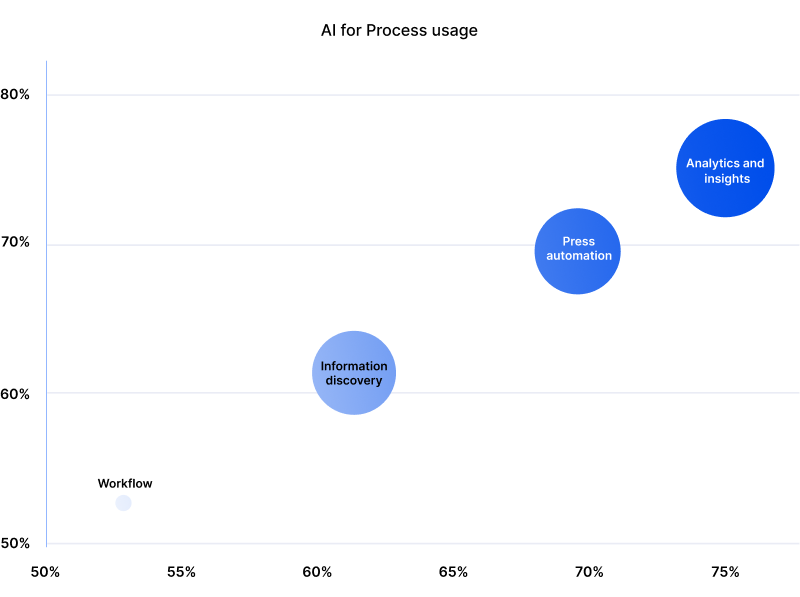
A closer look at how enterprises are using AI for process orchestration, analytics, and insights takes the lead, closely followed by process automation, helping enterprises reduce manual effort and scale execution with consistency. Information discovery and workflow optimization are also used by enterprises, enabling better access to data and smoother task orchestration across teams.
High-volume sectors drive AI process orchestration
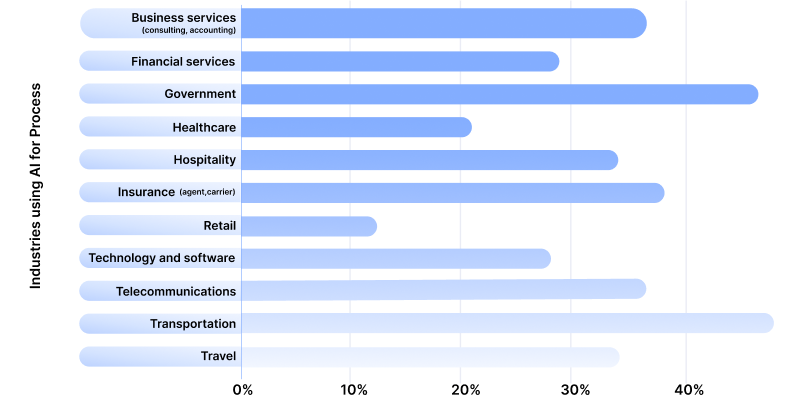
Many industries have deployed AI to orchestrate processes. Transportation and government stand out as the most active sectors embracing AI to manage their complex, high-volume operations and improve speed and regulatory compliance.
Closely following are sectors such as business services, insurance, telecommunications, travel, and financial services, which also show high AI adoption, likely because they handle frequent processes with relatively lower risk. In contrast, industries like healthcare and retail are adopting AI more cautiously, possibly due to less urgent needs for process streamlining and higher sensitivity around operations.
Talent gaps and security concerns slowdown the rollout
Transformation at this scale comes with its challenges. Participants say the greatest challenges their organizations are facing when bringing AI tools into their processes are a lack of AI talent and expertise (44%), data security/leakage concerns (40%), and regulatory compliance (37%).
Concerns, like costs, leadership approvals, and internal resistance, are not seen as major roadblocks, indicating strong executive alignment and view towards investing in AI for process automation and orchestration as a necessary investment.
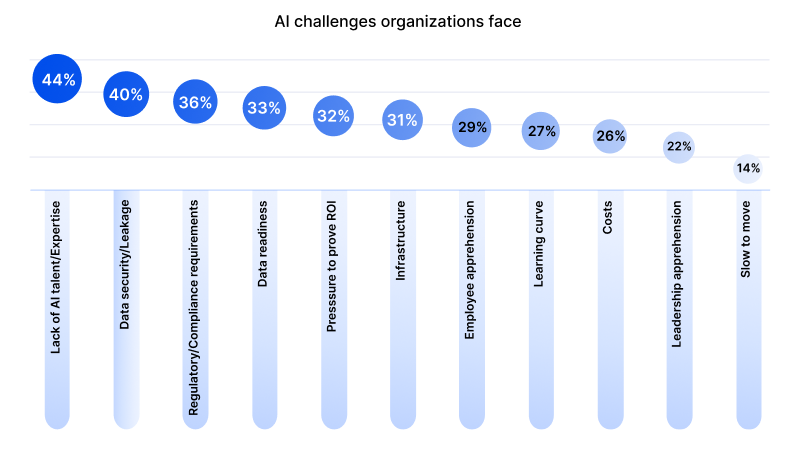
AI success is measured by operational gains
On responding to how organizations measure the value of their AI for business process orchestration initiatives, two metrics stood out: quality of output (13%) and operational efficiency (12.5%). Notably, ROI didn’t even rank in the top five, suggesting that while financial returns matter, enterprises are more focused on AI’s ability to strengthen execution and reduce operational risk.

AI talent and data quality top lessons
When considering past AI initiatives, nearly 70% of participants plan to hire additional AI expertise in preparation for future AI efforts. They are, however, divided as to whether they will be upskilling internally or hiring externally.
Beyond hiring AI talent, companies report their biggest lessons have involved improving data quality (54%), strengthening security (47%), and enhancing cross-team alignment (40%). These findings suggest that while often underestimated early on, these factors quickly become critical to successfully scaling AI initiatives.
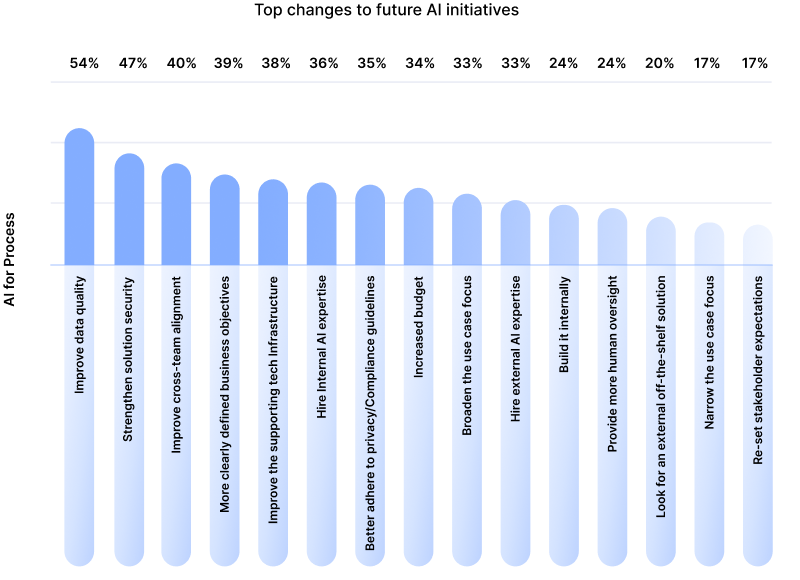
Businesses commit to expanding AI in core operations
Enterprise sentiment towards future investments in AI for business process orchestration is overwhelmingly optimistic. 88% of organizations say they plan to increase investment in AI for the process in the months ahead, with just 1% expecting a reduction.

Enterprises see the AI powered process automation and orchestration as a long-term, strategic pillar to modernize their core operations.
AI for customer service use cases: transforming customer support
Customer service today faces unprecedented pressure from rising customer expectations and an increasing demand for faster, more personalized support. As a result, businesses must innovate rapidly to deliver seamless, proactive customer experiences.
AI is playing a growing role in how enterprises serve, support, and connect with customers. From resolving issues faster to personalizing experiences at scale, AI for customer service is becoming a frontline differentiator, not just a back-office tool.
Support-led use cases lead customer-facing AI usage

Looking at how enterprises use AI for customer service, customer support & chatbots take the lead as the most widely adopted applications. Organizations are using AI to automate responses and assist human agents with real-time suggestions. The next most widely used applications are analytics and insights, helping organizations understand customer behavior and spot issues before they escalate. Virtual assistants are used to guide users through tasks or provide round-the-clock support.
Translation and personalization, though they remain relatively underused, present a clear opportunity to enhance tailored customer experiences.
Customer-intensive industries drive AI for customer service adoption
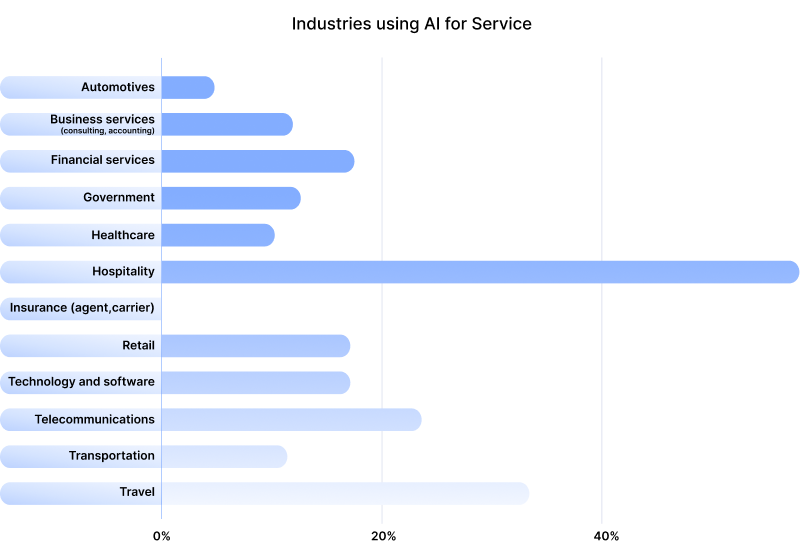
Industries that rely heavily on customer interaction, such as hospitality and travel, lead in adopting AI for customer service, using it to streamline queries, reduce wait times, and ensure consistent support during peak demand.
Sectors like telecommunications, financial services, retail, and technology are following closely. In contrast, sectors like insurance and automotive, despite managing large volumes of customer interactions, are taking a more cautious approach when it comes to using AI for direct customer service applications.
AI for customer service faces talent and security barriers
Implementing AI for customer service brings its unique challenges, with data security and leakage (44%) topping the list. As customers interact with chatbots and self-service tools, ensuring their personal information is protected is critical to maintaining trust.
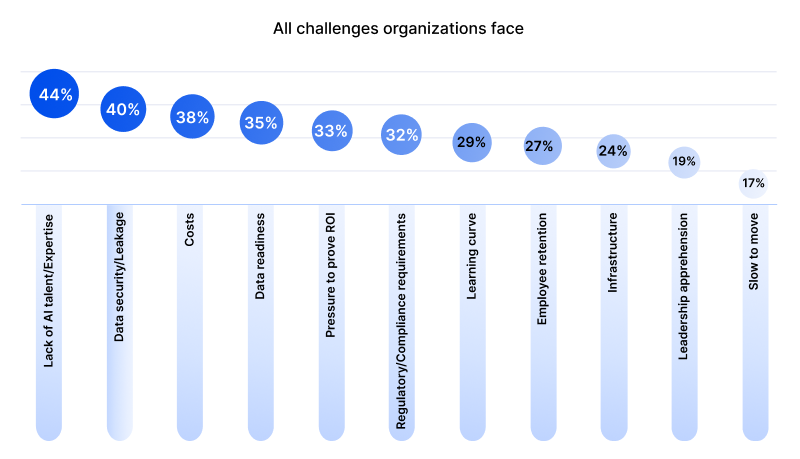
Lack of AI talent (40%), costs (38%), and pressure of ROI (33%) also weigh heavily on organizations, reflecting the challenge of scaling AI in high-volume environments. In contrast, infrastructure issues, leadership hesitation, and internal resistance remain relatively low, suggesting a strong organizational appetite to make AI work for customer experience.
Success in AI centers on customers
When it comes to measuring success, enterprises are keeping it customer-focused. Customer satisfaction leads (14.7%), followed by operational efficiency (10.8%), highlighting a dual priority of delighting users while keeping service delivery sharp and scalable.

Talent, data, and budget top AI for customer service priorities
Based on past AI projects, two-thirds are looking to strengthen AI expertise, either by upskilling internally or hiring externally. This requires organizations to both seek new employees with AI expertise and train existing employees to develop those skills.
Additionally, over half plan to improve data quality in preparation for future AI initiatives to take better advantage of their AI tools.
Securing more budget for their service-related AI initiatives was also identified as a top priority to achieve their goals and support their technology infrastructure requirements.
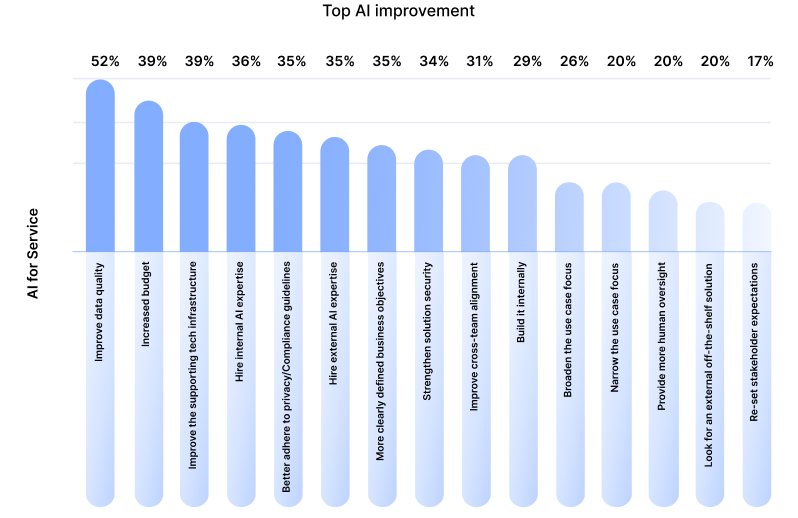
High confidence in AI for customer service use cases
Despite the challenges and learning curve, enterprise confidence in AI for customer service use cases remains high. 89% of enterprises say they will increase investments in AI for customer service in the coming months. Only 1% plan to scale back. That shows that AI is becoming a permanent part of how enterprises engage, respond, and retain their customers.

As enterprises shift from isolated experiments to scaled AI adoption, they are aligning not only on where AI will deliver the greatest impact, but also on who is driving these initiatives internally.
Consensus on the top AI use case for ROI

When it comes to expected ROI, organizations show comparable levels of alignment in how they rank the top three use case areas.
With enterprises of all sizes, applying AI for process automation and orchestration leads the way, identifying it as the area with the greatest ROI potential. Close behind is workplace productivity, while AI for customer service follows. The tight range of responses across company sizes tells that enterprises may differ in their approach, but they’re starting to agree on where AI matters most.
AI ownership aligns with functional expertise

When it comes to ownership of AI initiatives, enterprises are showing consistency in how responsibilities are distributed. CIOs are leading the way across all three use cases, reinforcing their expanding role as drivers of business transformation. At the same time, boards and finance teams have the least involvement, suggesting that AI is being prioritized as an operational tool rather than a financial debate.
Interestingly, CEOs are not among the top three influencers for any use case, though their involvement is slightly higher when it comes to AI for customer service, where customer experience and brand perception are at stake.
Department heads, on the other hand, are playing a stronger role in AI for workplace initiatives, where productivity and team-specific tools are more relevant. Developers and technical staff are taking the lead in AI for business process orchestration initiatives, even more so than Chief AI Officers or CEOs.
Across the board, the patterns show that AI ownership is aligning naturally to the strengths and roles of different functions within the organization.
C-Level Executives Shop for Holistic Solutions
As AI adoption matures, the conversation is shifting from where to use AI to how to scale it effectively. That means enterprise focus is now firmly on strategic decisions, particularly around building vs. buying and the criteria used to choose AI partners.
Enterprises favor buying over building AI solutions
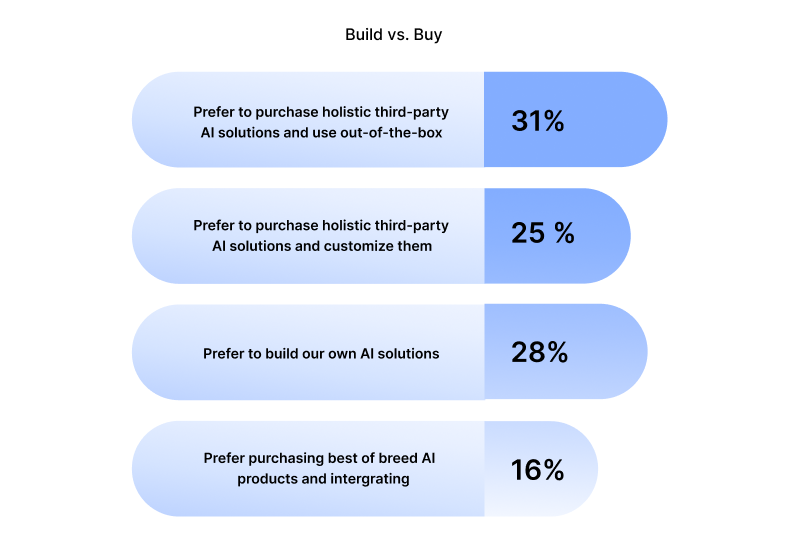
Regarding building vs buying, the clear majority of enterprises are leaning toward buying over building. Only 28% of organizations said they would build their own AI solutions, while the remaining 72% are exploring various purchase-led strategies.
Among them, there’s a preference for buying holistic third-party out-of-the-box, ready-to-deploy AI solutions (31%), indicating a strong desire for speed. Another 25% prefer buying third-party solutions and customizing them to their environment, and the remaining 16% prefer to assemble best-of-breed tools to create integrated stacks.
This data suggests that enterprises probably prefer control over complexity. They’re increasingly investing in partners who can deliver proven solutions with the ability to tailor, scale, and integrate, without needing to reinvent the wheel.
Practicality and performance lead AI vendor decisions
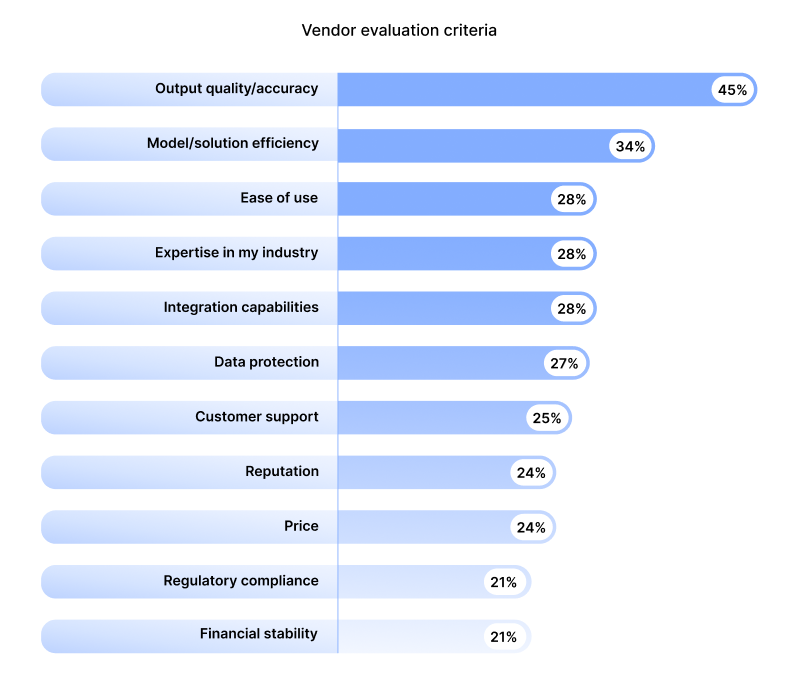
When evaluating potential vendors, output quality and accuracy (45%) is the most frequently considered characteristic, regardless of whether process, service, or work is believed to be most important.
Model/Solution efficiency (34%) ranked as the second most important consideration for companies shopping for an AI solution, and ease of use, industry expertise, and integration capabilities tied for third. This suggests that practical usability and contextual relevance now outweigh technicalities.
About Kore.ai
Kore.ai is a leading provider of agentic AI with over a decade of experience in helping enterprises realize business value. The Company provides strong business solutions leveraging AI for workplace, process automation, and customer service use cases. These are built on a comprehensive agent platform that brings together autonomous agents, sophisticated enterprise knowledge retrieval, intelligent agent orchestration, and no-code/pro-code tools. Kore.ai takes an agnostic approach to AI models, data, cloud infrastructure, and applications, giving customers freedom of choice. Trusted by over 450 Global 2000 companies, Kore.ai is helping the navigation of AI. Visit Kore.ai to learn more.
Kore.ai Business Solutions
Copyright Notice
©2025 Kore.ai. All rights reserved. AI Use Cases: Insights from AI Decision Makers is the exclusive property of Kore.ai.
No part of this publication may be copied, reproduced, stored in a retrieval system, or transmitted in any form or by any means—electronic, mechanical, photocopying, recording, or otherwise—without prior written permission from Kore.ai. This report may not be imported, resold, or redistributed for commercial purposes. Any approved use of data or insights from this publication must be clearly cited as follows: ©2025 Kore.ai, AI Use Cases: Insights from AI Decision Makers.
The insights and data provided in this report are for informational purposes only. While the findings are based on rigorous research and expert analysis, they may reflect interpretations and perspectives that do not necessarily represent the official position of Kore.ai.
Although every effort has been made to ensure the accuracy and reliability of the information contained herein, Kore.ai accepts no liability for errors, omissions, or any loss or damages arising from the use of this content. Readers are advised to use discretion when applying these insights to their own organizational contexts.

AI use cases: insights from AI's leading decision makers
Researched by Paradoxes and supported by Kore.ai, this report covers how enterprise leaders think about AI, primary use cases, challenges, success metrics, and planning.
Access Report







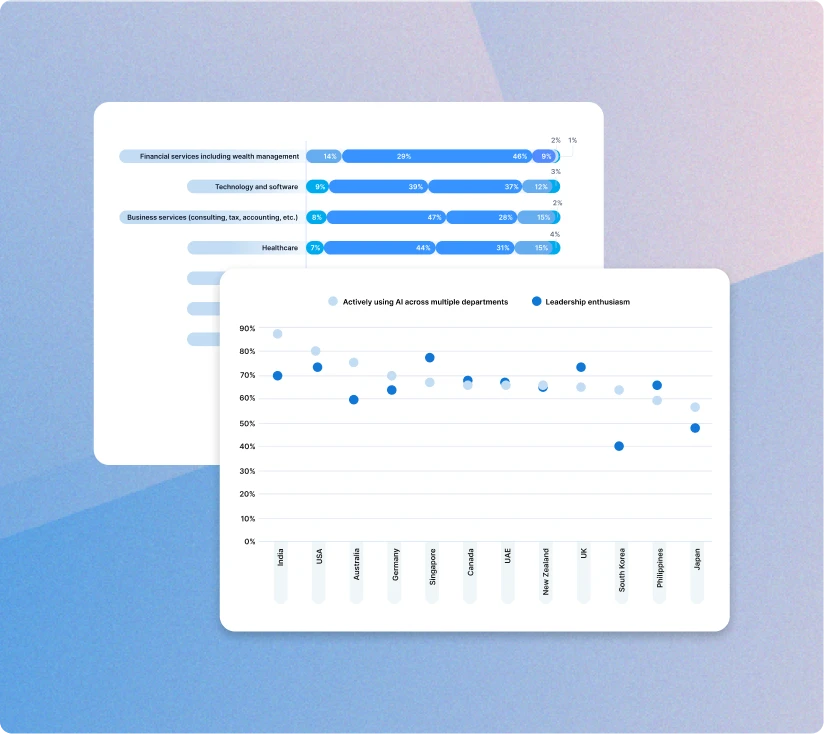




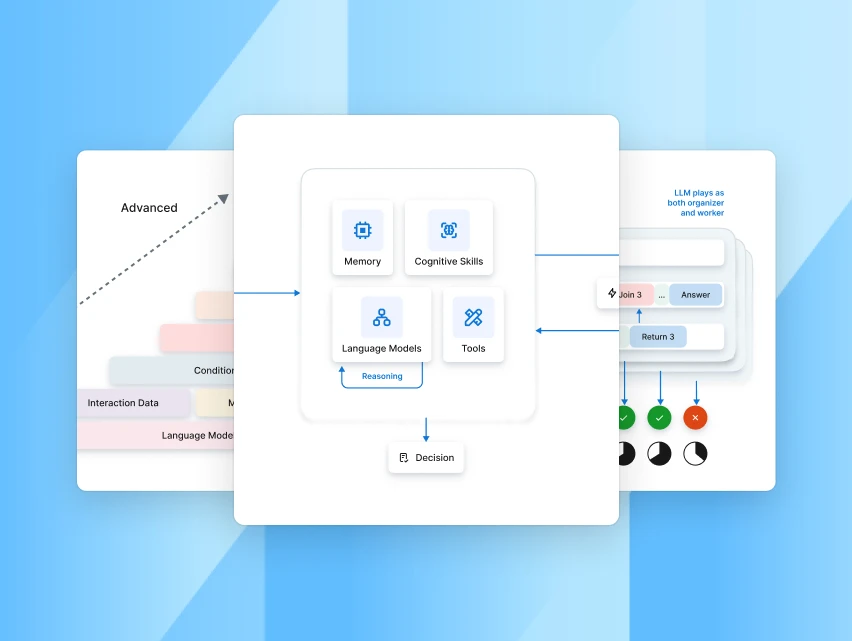

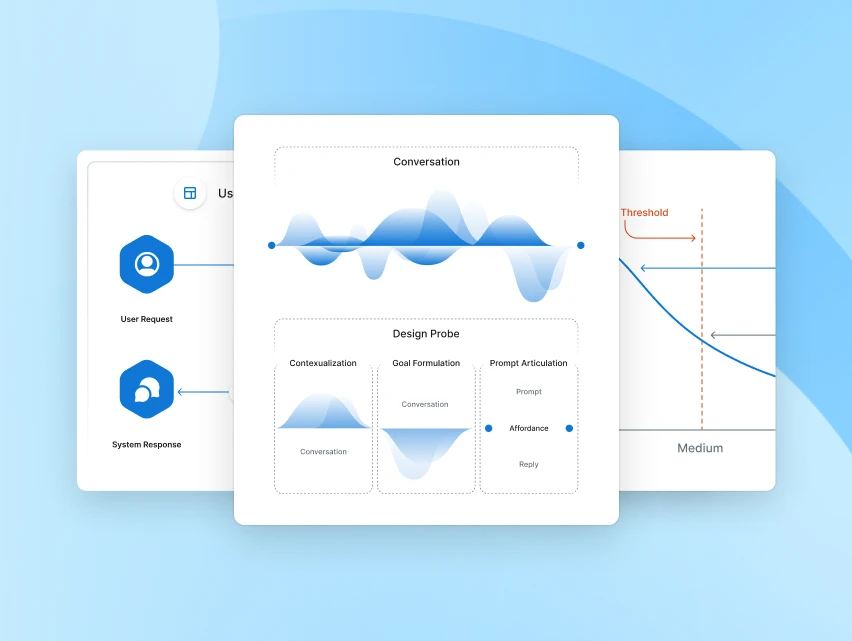
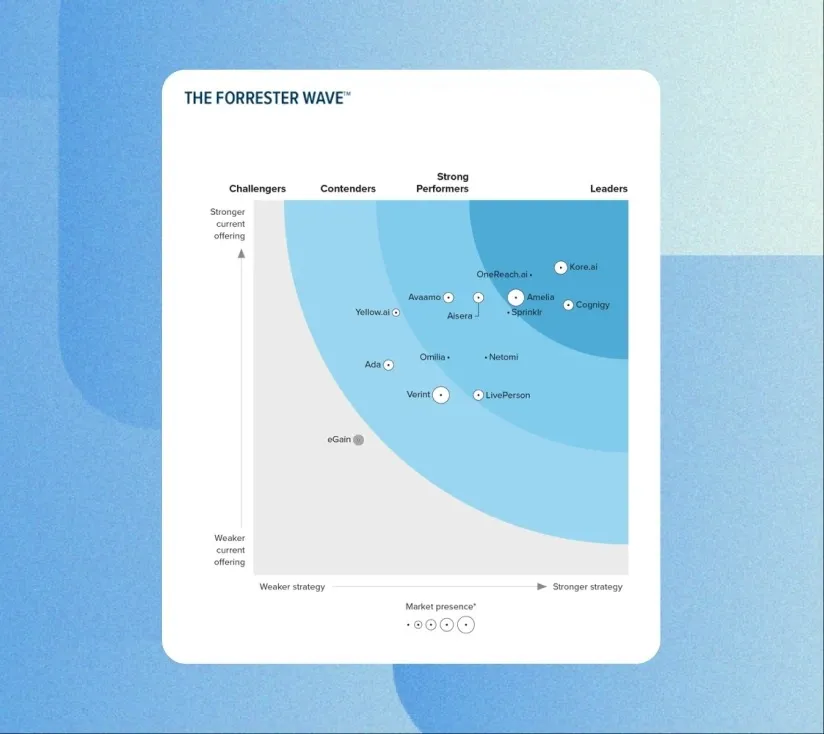


.webp)